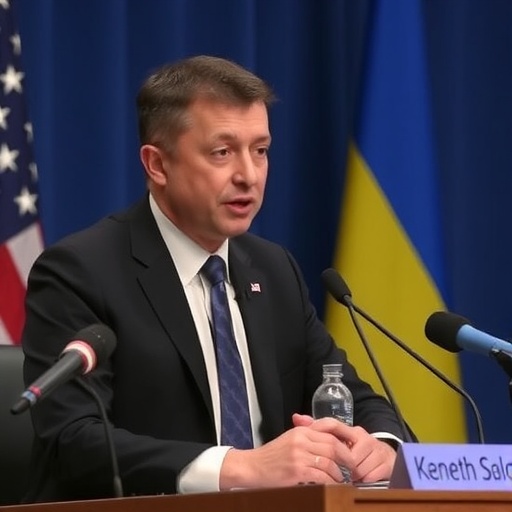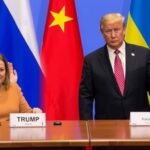Zelensky Demands Broader US Sanctions on Russian Oil and Long-Range Missiles to Bolster Ukraine’s Defense
In a bold escalation of calls for international support, Ukrainian President Volodymyr Zelensky has urgently appealed to the United States to impose sweeping sanctions on all Russian oil companies and to supply long-range missiles, emphasizing that these measures are essential to crippling Moscow’s war machine and defending Ukraine from ongoing aggression. This plea came hot on the heels of a high-stakes summit with European leaders in Brussels, where Zelensky highlighted the dire need for unified action against Russia’s invasion, now in its third year.
- Zelensky’s Fiery Address at Brussels Summit Signals Desperate Push for Unity
- Targeting Russian Oil: How Expanded Sanctions Could Starve the Kremlin’s War Effort
- Long-Range Missiles: Zelensky’s Bid to Extend Ukraine’s Reach Against Russian Aggression
- US and European Responses: A Patchwork of Support Amid Political Hurdles
- Implications for Ukraine’s Future: Pathways to Peace or Prolonged Standoff?
The request underscores the mounting pressure on Western allies as Russian forces continue to advance in eastern Ukraine, with recent reports indicating over 500,000 Ukrainian troops engaged on the front lines. Zelensky’s address painted a vivid picture of a nation under siege, where every delayed sanction or withheld weapon prolongs the suffering of civilians and soldiers alike. “We cannot afford half-measures when facing an aggressor fueled by petrodollars,” Zelensky stated, his voice carrying the weight of a leader who has become a symbol of resilience.
Zelensky’s Fiery Address at Brussels Summit Signals Desperate Push for Unity
The Brussels summit, convened by the European Union on October 15, 2024, brought together leaders from across the continent to discuss bolstering Ukraine’s defenses amid fears of a prolonged winter stalemate. Zelensky, arriving via video link from Kyiv due to security concerns, delivered a impassioned 20-minute speech that electrified the room. He detailed the human cost of the conflict, citing United Nations figures that show over 10,000 civilian deaths and the displacement of more than 6 million Ukrainians since Russia’s full-scale invasion began in February 2022.
“Russia’s economy thrives on its oil exports, which fund the bombs falling on our cities,” Zelensky declared, urging the US to expand US sanctions beyond the current targeted measures. Currently, sanctions cover major players like Rosneft and Gazprom, but exempt smaller firms that still contribute billions to Russia’s coffers. According to the International Energy Agency, Russian oil revenues reached $180 billion in 2023, despite Western embargoes, allowing President Vladimir Putin to sustain military operations without domestic economic collapse.
European leaders, including German Chancellor Olaf Scholz and French President Emmanuel Macron, nodded in agreement, with the EU pledging an additional €5 billion in military aid. However, Zelensky’s focus remained squarely on Washington, where political divisions have slowed aid packages. The summit’s joint communiqué explicitly supported Zelensky’s call for long-range missiles, weapons like the ATACMS that could enable Ukraine to strike deep into Russian-held territories, potentially altering the battlefield dynamics.
Targeting Russian Oil: How Expanded Sanctions Could Starve the Kremlin’s War Effort
At the heart of Zelensky’s demands lies a strategic assault on Russia’s most vital economic artery: its oil industry. Russia, the world’s third-largest oil producer, exports around 7.5 million barrels per day, with much of it rerouted to buyers in India and China to evade Western sanctions. Zelensky argued that broadening US sanctions to encompass every Russian oil entity would slash these revenues by up to 40%, based on estimates from the Center for a New American Security.
Historical context reveals the potency of such measures. The 2022 G7 price cap on Russian oil, set at $60 per barrel, initially reduced Moscow’s earnings by 30%, forcing discounts and logistical headaches. Yet, loopholes persist; shadow fleets of tankers, often uninsured and flagged in obscure jurisdictions, continue to transport crude. Zelensky proposed closing these gaps by sanctioning all entities involved in Russian oil transport and sales, a move that could mirror the comprehensive bans imposed on Iranian oil in the 2010s, which halved Tehran’s exports.
Experts weigh in on the feasibility. “Sanctioning the entire sector would send a clear message, but it requires global coordination to avoid market disruptions,” said Meghan O’Sullivan, a Harvard energy policy expert, in a recent interview. For Ukraine, the stakes are existential; oil funds not just tanks and artillery but also the recruitment of 300,000 additional Russian troops announced by Putin earlier this year. Without these revenues, Russia’s ability to procure weapons from allies like North Korea and Iran could falter, providing Ukraine with precious breathing room.
- Current Russian oil export destinations: India (40%), China (30%), Turkey (10%), others (20%)
- Projected revenue loss from full sanctions: $70-80 billion annually
- Ukraine’s alternative energy push: Solar and wind capacity up 25% since 2022
Zelensky’s advocacy ties directly to Ukraine’s energy security, as Russian strikes have damaged 50% of the country’s power infrastructure, leaving millions without heat as winter approaches.
Long-Range Missiles: Zelensky’s Bid to Extend Ukraine’s Reach Against Russian Aggression
Complementing the economic pressure, Zelensky’s request for long-range missiles represents a tactical game-changer for Ukraine’s beleaguered forces. Systems like the US-made ATACMS, with a range of up to 300 kilometers, would allow strikes on Russian logistics hubs, ammunition depots, and even airfields far from the front lines—targets currently out of reach for Ukraine’s Soviet-era arsenal.
The plea echoes earlier frustrations; in May 2024, the Biden administration finally approved limited ATACMS use, but restricted it to within Ukraine’s borders. Zelensky now seeks unrestricted deployment, arguing it’s necessary to counter Russia’s use of long-range weapons like the Kinzhal hypersonic missiles, which have terrorized Ukrainian cities. “If they can hit us from afar, why can’t we defend ourselves the same way?” he rhetorically asked during the summit.
Military analysts highlight the potential impact. A report from the Royal United Services Institute suggests that with long-range capabilities, Ukraine could disrupt 20-30% of Russian supply lines, echoing the success of HIMARS rockets in 2022 that helped reclaim Kherson. However, US hesitation stems from escalation fears; Russian officials have warned that such weapons crossing into their territory could invoke NATO’s Article 5. Despite this, Zelensky countered with data: Ukraine has already downed over 80% of incoming missiles using Western systems, preventing far greater casualties.
- Key long-range systems requested: ATACMS (US), Storm Shadow (UK/France), potentially JASSM cruise missiles
- Recent Ukrainian successes: Destruction of 15 Russian aircraft in September 2024 using drones
- Training timeline: Ukrainian troops could be proficient in weeks with US support
In the broader context of the Ukraine conflict, these missiles symbolize a shift from defensive to offensive posture, potentially forcing Russia to the negotiating table.
US and European Responses: A Patchwork of Support Amid Political Hurdles
Zelensky’s appeals have elicited a spectrum of reactions from key allies. In the US, the White House expressed “ongoing consideration” of expanded US sanctions, with Treasury Secretary Janet Yellen noting in a statement that “we’re exploring all options to tighten the noose on Russian oil revenues.” Yet, with the US presidential election looming, bipartisan support wavers; Senate Republicans have pushed for more aid, while some Democrats urge caution to avoid global energy spikes.
Europe, more unified, has already implemented its 12th sanctions package in June 2024, targeting Russian banks and energy firms. UK Prime Minister Keir Starmer pledged additional Storm Shadow missiles, while Poland’s President Andrzej Duda hosted a regional summit echoing Zelensky’s urgency. Quotes from the Brussels event capture the momentum: “Ukraine’s fight is Europe’s fight,” affirmed EU Commission President Ursula von der Leyen.
Challenges persist, however. Global oil prices, hovering at $75 per barrel, could surge 10-15% with full sanctions, impacting inflation in the West. Nonetheless, Zelensky’s narrative resonates, framing the requests as moral imperatives. Public opinion polls in the US show 62% support for aiding Ukraine, per Pew Research, bolstering his case.
Behind the scenes, diplomatic cables reveal intense lobbying; Zelensky’s team has met with US congressional leaders, presenting classified intelligence on Russian troop movements to underscore the timeliness of long-range missiles.
Implications for Ukraine’s Future: Pathways to Peace or Prolonged Standoff?
As Zelensky’s demands ripple through international forums, the path forward for Ukraine hinges on swift Western action. Broader sanctions on Russian oil could accelerate Russia’s economic downturn, with GDP growth projected to dip below 1% in 2025 by the IMF, potentially eroding Putin’s domestic support. Coupled with long-range missiles, this dual strategy might enable Ukraine to reclaim lost territories, such as those in Donbas, where Russian advances have stalled at a cost of 1,200 casualties per day, according to British intelligence.
Looking ahead, the upcoming NATO summit in Washington next summer could formalize commitments, including a pathway to membership for Ukraine—a red line for Moscow. Zelensky envisions a “coalition of the willing” to enforce sanctions, drawing in non-Western partners like Japan and Australia, who have already imposed their own restrictions on Russian energy.
Yet, risks loom large. Escalation could draw in more actors, with reports of North Korean troops aiding Russia adding urgency. For Ukraine, success means not just survival but sovereignty; Zelensky’s vision includes rebuilding with green energy, reducing reliance on fossil fuels that once bound Europe to Russia. As winter bites, the world watches: Will the US heed Zelensky’s call, transforming pleas into policy that tips the scales in this defining conflict?
In the end, these requests are more than military or economic tactics—they’re a clarion call for justice, reminding global leaders that Ukraine’s fate shapes the post-war order. Diplomatic channels buzz with activity, and analysts predict a US response within weeks, potentially reshaping the battlefield before year’s end.









